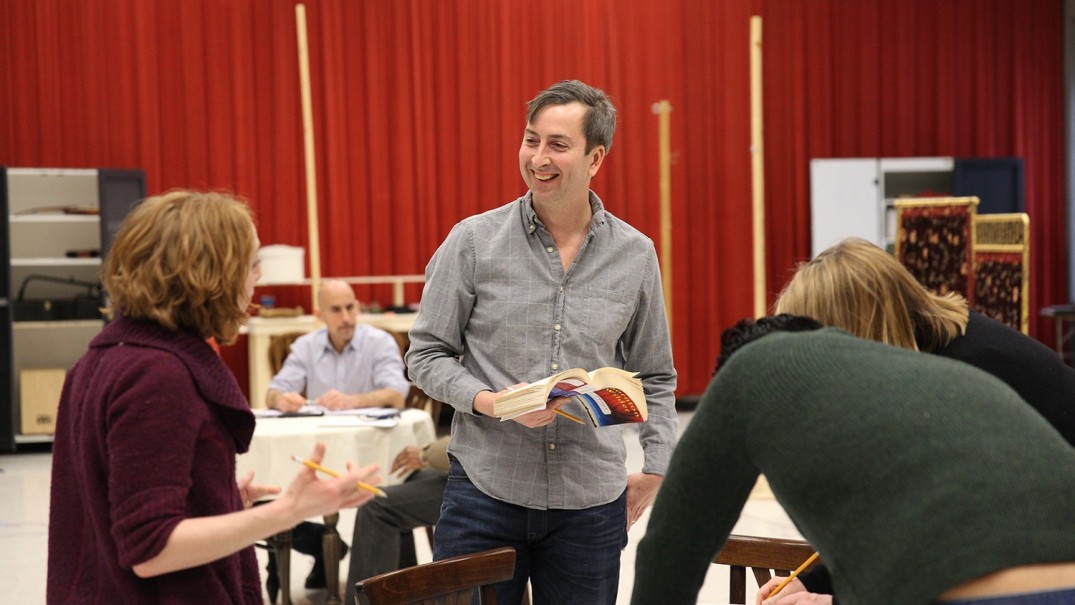Goodman Theatre Revives The Matchmaker
Thornton Wilder’s The Matchmaker returns to the city of its birth in a new production at Goodman Theatre directed by Artistic Associate Henry Wishcamper. The uproarious romp, which served as the inspiration for the musical Hello, Dolly!, follows the prickly, wealthy widower, Horace Vandergelder, who recruits the services of matchmaker Dolly Gallagher Levi to help him find a new wife. Little does Horace know that the vivacious Dolly has already found the perfect mate for Horace: herself! As Horace and Dolly set out from Yonkers to Manhattan to commence the search, a madcap mix of mistaken identity, outrageous misbehavior and spontaneous romance ensues.
“Wilder’s plays defy categorization by genre or type; unlike many of his realism-steeped contemporaries, he not only acknowledges the artificial environs of the stage but celebrates them, using them to reveal the absurdities of human action itself. Nowhere is this approach more evident than in his 1955 comic masterpiece The Matchmaker. Perhaps eclipsed in popularity by its musical iteration Hello, Dolly! and Wilder’s Our Town, The Matchmaker remains one of his best works, a fizzy, exuberant celebration of human foibles, romantic entanglements and the possibilities of connection in an often disconnected world.”
Director Henry Wishcamper, whose history of reexamining the classics includes Animal Crackers, The Little Foxes and A Christmas Carol, among others, consulted with Tappan Wilder, literary executor and nephew of Thornton Wilder for this production. [soliloquy slug="goodman"]
"We are pleased to put The Matchmaker in the hands this gifted director and his distinguished cast on a great stage in Chicago—the city my uncle adored and where the idea for his play germinated,” said Tappan Wilder. “Henry’s concept makes The Matchmaker a more universal play—or, in 21st century parlance, a more inclusive play—one that acknowledges our diverse society and captures the spirit of Thornton Wilder's dramatic vision, his view that art should be comprehensive, broadening and vast, should unite rather than divide.”
Actor Anita Hollander, who lost her leg in 1977 to cancer and whose career includes a one-woman show, Still Standing, joins the cast to portray multiple characters.
“ People with disabilities comprise nearly 20% of our population and cross all other forms of diversity. I am pleased that the Goodman Theatre includes performers with disabilities on their stages, particularly in The Matchmaker, wherein my three characters vary in age, personality, occupation, skill set and type of disability.”
Tony Award nominee Kristine Nielsen and Chicago favorite Allen Gilmore lead the diverse company of acclaimed talents and rising stars, seven of whom also play instruments including accordion, cajon, keyboard, mandolin, sitar, trumpet and even a musical saw live on stage during the show: Theo Allyn (Ermengarde), Behzad Dabu (Barnaby Tucker), Lawrence E. DiStasi (Rudolph/Cabman), Marilyn Dodds Frank (Flora Van Huysen), Sydney Germaine (Minnie Fay), Marc Grapey (Malachi Stack), Anita Hollander (Cook/Gertrude/Ensemble), Ronobir Lahiri (Ambrose Kemper), Elizabeth Ledo (Mrs. Malloy), Postell Pringle (Cornelius Hackl) and Ron E. Rains (Joe Scanlon/August).
In creating the scenic and costume elements, Wishcamper encouraged his creative team to root the production in 1890s New York but also explore Wilder’s affinity for anti-realism. Set Designer Neil Patel’s set uses scenic touches—sparse furniture, curtains, birdcages—to suggest the style and atmosphere of a room, while leaving other artistic elements, like the city skyline, fully visible on stage. "Wilder was working against the naturalistic style of his time,” explained Patel. “Similarly today, we spend a lot of time looking at sets that are supposed to be ‘real’ or whatever that could possibly mean. It is wonderful to have the liberty that this play inspires to use the full imaginative power of the stage.”
Costume Designer Jenny Mannis’ designs span several class strata of 1890s New York, from the rough and tumble to the romantic and elegant. “I love the opportunity to explore the grittiness and exuberance of this time in our history; much like today, it was a period of enormous change in American society,” says Mannis. “We have enjoyed delving into that history and looking at images that represent American diversity in a way that isn't always shown in textbooks.” The design team also includes David Lander (lights) and Richard Woodbury (sound). Kathleen Petroziello and Alden Vasquez are the Production Stage Managers.
Learn more at www.goodmantheatre.org/Matchmaker

